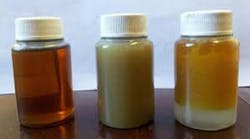*Editor's Note: This article was updated in February 2024.
If you've worked with hydraulic equipment for any length of time, it's likely that you've come across a hydraulic system with cloudy oil. Oil becomes cloudy when it is contaminated with water above its saturation level.
The saturation level is the amount of water that can dissolve in the oil's molecular chemistry and is typically 200-300 ppm at 68 F (20 C) for mineral hydraulic oil. Note that if hydraulic oil is cloudy it indicates that a minimum of 200-300 ppm of water is present. I recently audited a hydraulic system with cloudy oil that was found to contain greater than 1% (10,000 ppm) water.
How Does Water Effect Hydraulic Oil?
Water in hydraulic oil has a number of negative effects:
- Depletes some additives and reacts with others to form corrosive by-products which attack some metals.
- Reduces lubricating film-strength, which leaves critical surfaces vulnerable to wear and corrosion.
- Reduces filterability and clogs filters.
- Increases air entrainment ability.
- Increases the likelihood of cavitation occurring.
Ways to Remove Water from Hydraulic Oil
Methods for removing free (unstable suspension) and emulsified (stable suspension) water include:
- polymeric filters;
- vacuum distillation; and
- head space dehumidification.
Vacuum distillation and head space dehumidification also remove dissolved water.
Polymeric Filters
These look like conventional particulate filters, however the media is impregnated with a super-absorbent polymer. Water causes the polymer to swell, which traps the water within the media. Polymeric filters are best suited for removing small volumes of water and/or maintaining water contamination within pre-determined limits.
Vacuum Distillation
This technique employs a combination of heat and vacuum. At 25 in. Hg, water boils at 133 F (56 C). This enables water to be removed at a temperature that does not damage the oil or its additives.
Head Space Dehumidification
This method involves circulating and dehumidifying air from the reservoir head space. Water in the oil migrates to the dry air in the head space and is eventually removed by the dehumidifier.
Like all other forms of contamination, preventing water ingress is cheaper than removing it from the oil. A major point of water ingression is through the reservoir head space. Many hydraulic system reservoirs are fitted with breather caps that allow moisture (and particles) to enter the reservoir as the oil volume changes through either thermal expansion and contraction, or the actuation of cylinders.
Replacing the standard breather cap with a hygroscopic breather will eliminate the ingression of moisture and particles through the reservoir's vent. These breathers combine a woven-polyester media that filters particles as small as 3 microns, with silica gel desiccant to remove water vapor from incoming air. The result is relative humidity levels within the reservoir head space that make condensation unlikely, therefore reducing water contamination of the oil.
Bottom line: failure to address water contamination can be a very costly mistake. And to discover six other costly mistakes you want to be sure to avoid with your hydraulic equipment, get "Six Costly Mistakes Most Hydraulics Users Make... And How You Can Avoid Them!" available for FREE download here.

